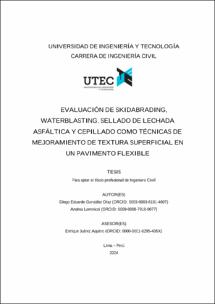Mostrar el registro sencillo del ítem
Evaluación de skidabrading, waterblasting, sellado de lechada asfáltica y cepillado como técnicas de mejoramiento de textura superficial en un pavimento flexible
| dc.contributor.advisor | Juarez Aquino, Enrique | |
| dc.contributor.author | González Díaz, Diego Eduardo | |
| dc.contributor.author | Lomniczi, Andrea | |
| dc.date.accessioned | 2024-07-09T21:01:26Z | |
| dc.date.available | 2024-07-09T21:01:26Z | |
| dc.date.issued | 2024 | |
| dc.identifier.citation | González Díaz, D. E. y Lomniczi, A. (2024). Evaluación de skidabrading, waterblasting, sellado de lechada asfáltica y cepillado como técnicas de mejoramiento de textura superficial en un pavimento flexible [Tesis de Título Profesional, Universidad de Ingeniería y Tecnología]. Repositorio Institucional UTEC. https://hdl.handle.net/20.500.12815/381 | es_PE |
| dc.identifier.uri | https://hdl.handle.net/20.500.12815/381 | |
| dc.description.abstract | La presente investigación busca orientar a contratistas y clientes que busquen incrementar la macrotextura y la microtextura de un pavimento asfáltico además de cubrir la brecha en la literatura y proporcionar un enfoque sistemático a los tomadores de decisiones en cuanto a los métodos de retexturizado existentes. Para lograr los objetivos de la investigación, esta fue dividida en tres etapas. En la primera etapa, se evaluaron teóricamente las técnicas de waterblasting, cepillado, skidabrading y sellado de lechada asfáltica mediante el método de selección por ventajas. Tras dicha evaluación, se concluyó que waterblasting y skidabrading ofrecen mayor valor por dinero. En la segunda etapa del estudio, se aplicó el waterblasting y skidabrading en dos tramos de 300 metros de pavimento asfáltico. Se realizaron mediciones de macrotextura y microtextura del pavimento antes y después de los tratamiento variando la velocidad del skidabrading y la presión del agua en el waterblasting. Los resultados revelaron que mientras el tratamiento con skidabrading cumplió satisfactoriamente con los requisitos de macrotextura y microtextura exigidos por la RAP 314, el método de waterblasting no alcanzó los mismos estándares. Por último, en la tercera etapa, se utilizaron pruebas estadísticas de Kruskal-Wallis, ANOVA y la correlación de Spearman para explorar las relaciones entre las variables. Este análisis demostró que existe una correlación negativa moderada entre velocidad y macrotextura mas no entre velocidad y microtextura. Por otro lado, con waterblasting, se observó una correlación positiva moderada entre presión y microtextura mientras que no se encontró correlación entre presión y macrotextura. | es_PE |
| dc.description.abstract | This research aimed to provide guidance to contractors seeking to increase the macrotexture and microtexture of an asphalt pavement as well as to provide a systematic approach to decision-makers regarding retexturing methods. In the first stage of the research, waterblasting, grooving, skidabrading and slurry seal techniques were evaluated using the Choosing by Advantage method. After this evaluation, it was concluded that waterblasting and skidabrading offer the best value for money. In the second stage, waterblasting and skidabrading were applied to two 300-meter sections of asphalt pavement. Measurements were made of the macrotexture and microtexture before and after the treatments by varying the speed and pressure. The results revealed that while the skidabrading treatment satisfactorily met the macrotexture and microtexture requirements of RAP 314, the waterblasting method did not. Finally, in the third stage, Kruskal-Wallis, ANOVA and Spearman's correlation statistical tests were used to explore the relationships between the variables. This analysis showed that there is a moderate negative correlation between speed and macrotexture but not between speed and microtexture. On the other hand, with waterblasting, a moderate positive correlation was observed between pressure and microtexture while no correlation was found between pressure and macrotexture. | es_PE |
| dc.description.uri | Tesis | es_PE |
| dc.format | application/pdf | es_PE |
| dc.language.iso | spa | es_PE |
| dc.publisher | Universidad de Ingeniería y Tecnología | es_PE |
| dc.rights | info:eu-repo/semantics/closedAccess | es_PE |
| dc.rights.uri | http://creativecommons.org/licenses/by-nc-nd/4.0/ | |
| dc.source | Repositorio Institucional UTEC | es_PE |
| dc.source | Universidad de Ingeniería y Tecnología - UTEC | es_PE |
| dc.subject | Evaluación estructural de pavimento | es_PE |
| dc.subject | Evaluación de microtextura | es_PE |
| dc.subject | Evaluación de macrotextura | es_PE |
| dc.subject | Pavement structural evaluation | es_PE |
| dc.subject | Microtexture evaluation | es_PE |
| dc.subject | Macrotexture evaluation | es_PE |
| dc.title | Evaluación de skidabrading, waterblasting, sellado de lechada asfáltica y cepillado como técnicas de mejoramiento de textura superficial en un pavimento flexible | es_PE |
| dc.title.alternative | Evaluation of skidabrading, waterblasting, slurry sealing and grooving as surface texture improvement techniques on a flexible pavement | es_PE |
| dc.type | info:eu-repo/semantics/bachelorThesis | es_PE |
| dc.subject.ocde | https://purl.org/pe-repo/ocde/ford#2.01.01 | es_PE |
| dc.publisher.country | PE | es_PE |
| thesis.degree.discipline | Ingeniería Civil | es_PE |
| thesis.degree.grantor | Universidad de Ingeniería y Tecnología. Ingeniería Civil | es_PE |
| thesis.degree.level | Título Profesional | es_PE |
| thesis.degree.name | Ingeniero Civil | es_PE |
| renati.advisor.dni | 72461916 | |
| renati.advisor.orcid | https://orcid.org/0000-0001-6295-406X | es_PE |
| renati.author.cext | 000241141 | |
| renati.author.dni | 74121714 | |
| renati.author.orcid | https://orcid.org/0009-0003-6191-4607 | es_PE |
| renati.author.orcid | https://orcid.org/0009-0008-7910-0077 | es_PE |
| renati.discipline | 732016 | es_PE |
| renati.juror | Bedriñana Mera, Luis Alberto | |
| renati.juror | Caicedo Murillo, Felix | |
| renati.juror | Juarez Aquino, Enrique | |
| renati.level | http://purl.org/pe-repo/renati/level#tituloProfesional | es_PE |
| renati.type | http://purl.org/pe-repo/renati/type#tesis | es_PE |
Ficheros en el ítem
Este ítem aparece en la(s) siguiente(s) colección(es)
-
Ingeniería Civil [5]






